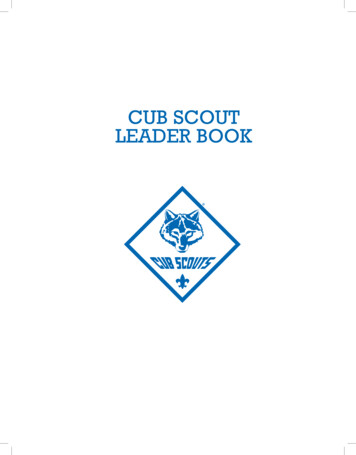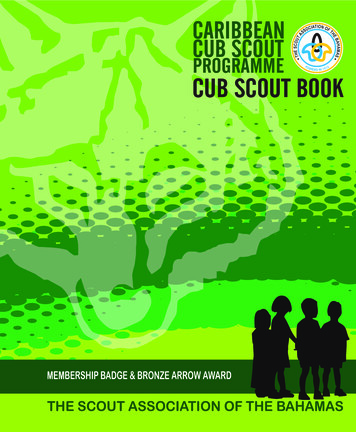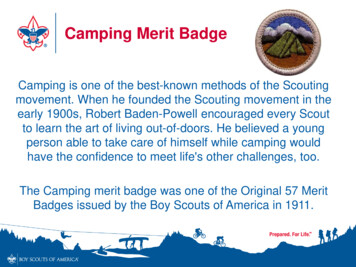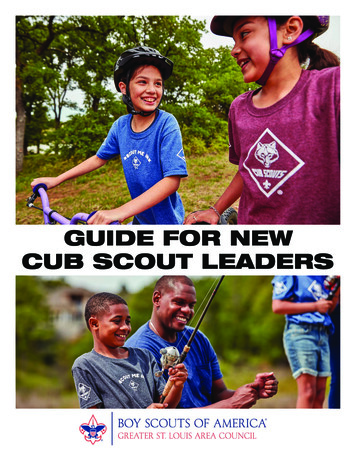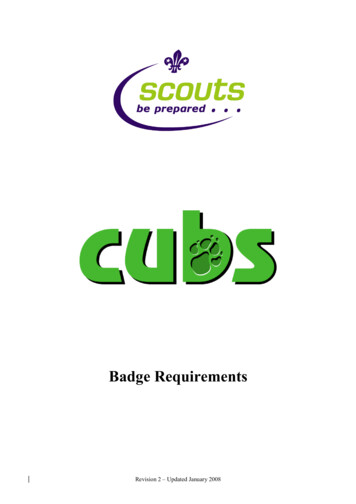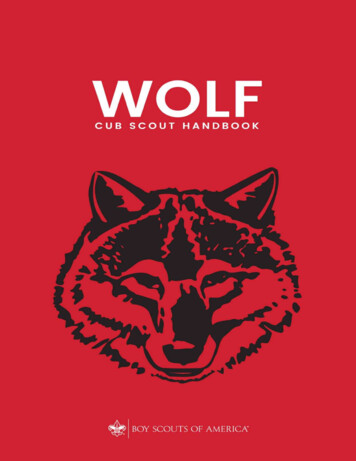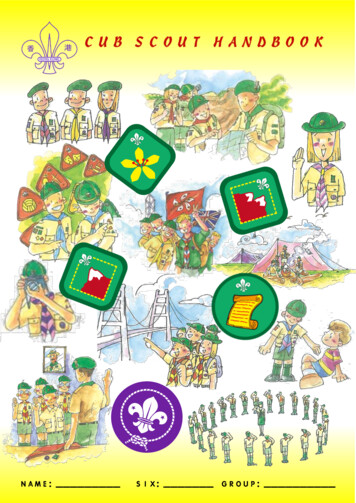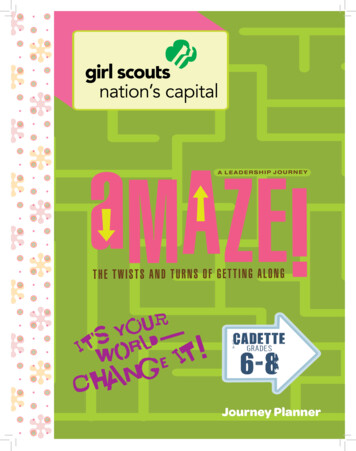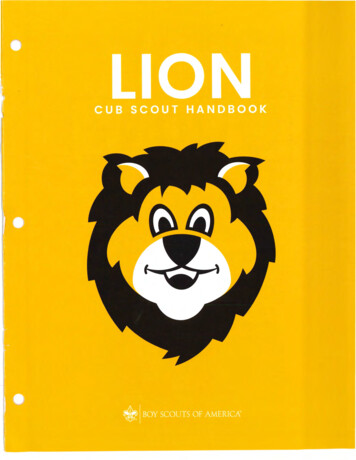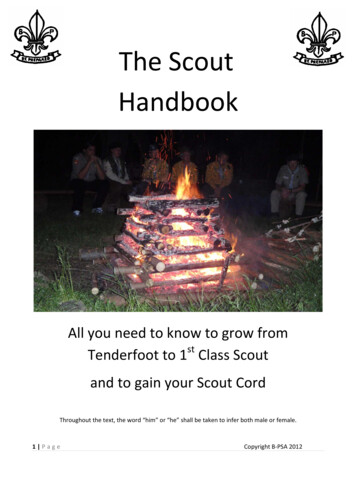
Transcription
The ScoutHandbookAll you need to know to grow fromTenderfoot to 1st Class Scoutand to gain your Scout CordThroughout the text, the word “him” or “he” shall be taken to infer both male or female.1 PageCopyright B-PSA 2012
Welcome to Scouting, an adventure that will take you from being a ten or eleven yearold Tenderfoot to becoming a First Class Scout and beyond.The Baden-Powell Scouts’ Association is proud to maintain the Traditional Scoutingskills and values that our founder believed in, but we are equally proud of our ability tomix those skills and values with some thoroughly modern adventures.This handbook will guide you through your progression and development in Scoutingand will give you links to other resources that will help you. You have probably justcome from the Wolf Cub Pack - you are now at the start of a journey of fun, adventureand learning and maybe you will end up being a Patrol Leader and wearing the Scout Cord, the highestaward a Scout can get before they are fifteen – I hope that’s what you are going to aim for.There are tests to be completed at each stage as you progress to gaining your Scout Cord, but they are notlike school tests - your Patrol Leader, fellow Scouts and your leaders will help you learn the skills and whenyou can show that you have mastered them they will sign off your record card.The tests are grouped like this: Tenderfoot – some simple tests to complete before you are invested as a Scout – if you have gainedyour Leaping Wolf you have already completed all the Tenderfoot tests.Second Class – these are the basic skills that you will need to enjoy the wonderful outdoor life of aScoutFirst Class – these skills prepare you for adventures where you take far more personal responsibility,until you can go on your first class journeyScout Cord – the highest award, to be gained before you are 15 and move to Senior Scouts.Baden-Powell wrote a series of articles called Scouting for Boys which excited young people over 100 yearsago, and they started to form Scout Patrols and Troops. He wrote those articles under eight headings and westill use similar headings today, and you will see them throughout this handbook: Scoutcraft and ChivalryExplorationCamp SkillsObservationWoodcraftHealth and FitnessSaving LifeCitizenshipEnjoy Scouting, I look forward to meeting you during your adventuresJayHeadquarters Commissioner for Scouts2 PageCopyright B-PSA 2012
TenderfootThis is the most important badge you will ever be awarded as a Scout.There will be other badges that prove that you have learned more skills and had moreadventures, but this badge shows that you have made a solemn promise in front ofother Scouts, and you are going to do your best to obey the Scout Law.Scoutcraft and Chivalry1. Understand the history of Scouting, the Baden-Powell Scout Association and the WorldFederation of Independent Scouts. Know about the life and achievements of Lord BadenPowell, our Founder.Page42. Know about the Scout section progressive award scheme and how it is structured.53. Know the Scout Law and Promise, and their meaning in accordance with age.64. Know the use and demonstrate the salute, sign, handshake and motto as explained in CampFire Yarn 3 of ‘Scouting for Boys'.65. Take part in a Patrol or Troop activity.Camp Skills6. Demonstrate with ropes how to tie the following knots: Reef knot, Sheet bend, Clove hitch,Bowline, Round turn and two half hitches, Sheepshank. Explain their uses.6787. Whip the end of a rope.Observation8. Demonstrate and follow the woodcraft signs given in Camp Fire Yarn 4 of ‘Scouting forBoys'.9Citizenship9. Know the history and composition of the Union Flag and demonstrate how to hoist, breakand fly it.103 PageCopyright B-PSA 2012
Robert Stephenson Smyth Baden-Powell was the founder of Scouting. He was Born on22 Febuary 1857.B-P’s father died when he was three years old, and his early education was at home,where his mother encouraged him to learn about animals, plants and birds. B-P soondiscovered he could draw very well using either hand, and he became expert at imitatingbird calls.After school, at the age of 19 B-P, joined the army and did so well in his entrance exams that he wasimmediately posted as an officer with the 13th Hussars in India. He gained rapid promotion and hadmany famous victories, making him a hero to the British public.During the Boer War in Africa, Colonel Baden-Powell decided to tie up large numbers of Boer Troops byholding the strategically important town of Mafeking in South Africa, and the Siege of Mafekingbecame one of the most important actions of the war. B-P’s book called 'Aids to Scouting' sold well bothto the military and public at large, and particularly appealed to teenage boys.In 1907 B-P re-wrote 'Aids to Scouting', to aim it at a younger audience and called it 'Scouting for Boys'.Later that year he ran an experimental camp with 22 boys from different backgrounds, on BrownseaIsland, Poole Harbour, Dorset to try out his ideas. In 1908 B-P republished his book as “Scouting forBoys”, in 6 fortnightly instalments, boys started to buy this and create their own Patrols. Troops werethen formed and Scouting began. From there it spread all over the world. B-P ran a camp for anothergroup of Boy Scouts in Humshaugh, Northumbria - this was the first true Scout camp.In the next ten years Girl Guides, Wolf Cubs and Rover Scouts started, and Scout Rallies were held in themajor cities of Great Britain. In 1920 the first international Scout Jamboree was held and B-P was namedChief Scout of the world.In the following ten years B-P visited many countries to establish Scouting across theworld. Gilwell Park was presented to the Movement for the Woodcraft training ofScouters.B-P died on January 8th 1941 and was buried in Nyeri at the base of Mount Kenya.He had the remarkable experience of seeing the movement grow from the tiny acorn ofa small group of children camped on Brownsea Island into a Brotherhood andSisterhood which embraces almost the whole world.The Baden-Powell Scout's Association was formed in 1970, following moves by the Scout Association inthe mid 1960s to modernise their image. Founders of our Association felt that rest of the ScoutMovement was abandoning the traditions and intentions set out by B-P. The Baden-Powell Scouts retain4 PageCopyright B-PSA 2012Scoutcraft – 1. History of ScoutingB-P attended Rose Hill School, in Tunbridge Wells and then won a Scholarship to Charterhouse School inLondon. It was here that he explored his interest of wood-craft and learned lots of his scouting skills.Although officially off limits, he would sneak out into the wood surrounding his school where he learnedto move silently to avoid detection. He also caught and cooked rabbits and other animals, being carefulnot to give his position away with smoke.Tenderfoot1. Understand the history of Scouting, the Baden-Powell Scout Association and the World Federationof Independent Scouts. Know about the life and achievements of Lord Baden-Powell, our Founder.
It is a voluntary, educational charity movement for young people. It is independent, non-political, nonmilitary, and open to all without distinction of origin, race, creed or gender, in accordance with the purpose,principles and method conceived by Robert Baden-Powell.As an independent Scout Association, B-PSA are members of the the World Federation ofIndependent Scouts (WFIS). The WFIS was formed in 1996 and is a world body that recognisesIndependent Scouts Associations which teach traditional Scouting values, in countries across theglobe.Tenderfootthe belief that essence of the movement should be based on outdoor activities related to the skills ofexplorers and backwoodsmen.Notable Scouting 94619571970198220072008Brownsea Island – Experimental CampScouting for Boys. First Scout Camp - HumshaughBoy Scouts of America. An American businessman, William Boyce, was visiting London, and lost hisway in the fog. A small boy offered to show him the right way. Mr. Boyce wanted to pay him for histrouble, but the boy refused to accept the money, saying “A Scout does not take money for doing aGood Turn”. Mr. Boyce was amazed that the boy should refuse, and wanted to find out more aboutScouts. Next day he sought out the office and took back books about Scouting to his home inAmerica. He thought it was such a good way of training boys that he started the movement overthere.Crystal Palace RallyWolf Cubs formed.Rover Scouts formed.Gilwell Park opened.The first World Jamboree at Olympia.The Second World Jamboree at Copenhagen.The Third World Jamboree at Birkenhead (Liverpool) (B-P created Lord Baden-Powell of Gilwell)First World Rover MootThe First Gang ShowThe Fourth World Jamboree at Godollo (Hungary)The Fifth World Jamboree at Vogelensang (Netherlands)Death of Baden-Powell. 8th January.Senior Scouts formed.Bi-Centenary Jamboree, Sutton Park, Birmingham.Baden-Powell Scouts Association formed.Beaver Scouts officially formed in the UK.B-PSA celebrate 100 years of Scouting at Camp Cricket and visit Brownsea IslandB-PSA celebrate the 100th anniversary of the Humshaugh camp, by camping near the original site5 PageCopyright B-PSA 2012Scoutcraft – 1. History of Scouting190719081909
There are tests to be completed at each stage as you progress through the Scout section, but they are notlike school tests - your Patrol Leader, fellow Scouts and your leaders will help you learn the skills and whenyou can show that you have mastered them they will sign off your record card.Tenderfoot2. Know about the Scout section progressive award scheme and how it is structured.The tests are grouped like this, and are described in detail later in this handbook:Tenderfoot – some simple tests to complete before you are invested as a Scout – if you have gainedyour Leaping Wolf you have already completed all the Tenderfoot tests. You should normallycomplete these within three months of starting in the Scout Section. Second Class – these are the basic skills that you will need to enjoy the wonderful outdoor life of aScout. It will probably take you a year or so to gain these skills, but you will of course also be goingon camps and outings at the same time, and working on proficiency badges for your favouriteactivities. First Class – these skills prepare you for adventures where you take far more personal responsibility,until you can go on your first class journey. It may well take you a while to gain all these skills, and atthe same time you will be helping younger Scout’s gain their skills. You will start to be given morefreedom to take care of yourself on camp and expeditions and take even more proficiency badges. Scout Cord – the highest award before you go to Senior Scouts, and must be completed before your15th birthday. It will need you to complete proficiency badges from a special list, and to have your 1stClass.6 PageCopyright B-PSA 2012Scoutcraft – 2. Progressive Award Scheme
The Scout Law & Promise are very important in the move from being someone who goes along to Scoutmeetings, to becoming a Scout. There are ten Laws which you will need to learn, however, is not enough justto be able to repeat the Laws, you are going to promise to do your best to obey them, and that is a bigundertaking.Behind each Law lies a great depth of meaning, talk to other Scouts, Senior Scouts and Rover Scouts, toAkela and your Scout Leaders about what the Laws mean to them, and how they try to live by them – theyhave all promised to obey the same Laws as you.2. A Scout is loyal to The Queen, His Country, His Scouters, His Parents, His Employers and to thoseunder HimLoyalty means that you don’t let people down, and they can rely on you, and that doesn’t just apply topeople that you look up to. If you become a Patrol Leader, you will have to earn the respect of themembers of your Patrol, and be faithful to them especially.3. A Scouts' duty is to be useful and help othersA Scout should do their duty first. In order to understand their duty, B-P suggested that a Scout shouldconsider,"Which is my duty?" that is, "Which is best for other people?" - and do that one.A Scout should Be Prepared to do a good turn every day and help people, without seeking reward forbeing helpful.4. A Scout is a friend to all, and a brother to every other Scout, no matter to what Country, Class orCreed the other may belongWhen meeting another Scout, we should treat each other as we would expect to be treated. A Scoutshould offer help & support and must never look down upon the other. A Scout accepts the other asthey find them.Start by practising this in your Patrol, then your Troop, then with Scouts you meet from other Troops,and eventually if you are lucky with Scouts from other countries. Nearly 50 million people in almost 200countries are involved in Scouts and Guides. You are now part of that worldwide brotherhood for peaceand good.5. A Scout is courteousA Scout should be polite to everyone, no matter how the other person treats you, or speaks to you.6. A Scout is a friend to animalsA Scout should be kind to all animals and save them as far as possible from pain, and should not kill anyanimal unnecessarily.7. A Scout obeys orders of His parents, Patrol Leader, or Scout Master without question7 PageCopyright B-PSA 2012Scoutcraft – 3. Law and PromiseThe Law:1. A Scouts' honour is to be trustedA true Scout can be recognised because he lives this Law, he can be trusted to speak the truth, and nevergo back on his word. He can always be trusted to carry out any job to the best of his ability.Tenderfoot3. Know the Scout Law and Promise, and their meaning in accordance with age.
8. A Scout smiles and whistles under all difficulties.You will find that life throws all sorts of difficulties at you, things that you don’t want to do, or make youfeel frightened or uncomfortable. Moaning and grumbling about these will just make you miserable, andwill probably make those around you miserable or angry. See what happens when you tackle every daywith a smile on your face – you’ll find it’s infectious.10. A Scout is clean in thought, word and deed.Scouts should not let themselves give way to temptation, either to think, talk or do anything whichwould be considered unacceptable.There is a useful little rhyme to help you remember the key words for each Law their order:Trusty, Loyal, Helpful,Brotherly, Courteous, Kind,Obedient, Smiling, Thrifty,Clean in word, deed and mind.The Scout PromiseOn My Honour I promise,That I will do my best,To do My Duty to God and The Queen,To help other people at all times, and to obey The Scout Law.This is the solemn promise that you make when you are invested, and is the same promise that all SeniorScouts, Rover Scouts and Leaders make. You will make this promise in front of the other Scouts in yourTroop, and they will trust you to do your best to keep it. Later when you are present for a new Scout beinginvested you should take the opportunity to remind yourself of the things you promised to do.You are at an age now, when you can make up your own mind about what the word God means to you, itmay be a religious deity, or it may be a set of personal values and beliefs – the important thing is that youhold true to your beliefs, and respect the beliefs of others.8 PageCopyright B-PSA 2012Scoutcraft – 3. Law and Promise9. A Scout is thriftyThrift means carefulness to avoid waste – it applies to money, property and time. Think carefully in aworld where we are wasting valuable resources how you can make a difference.TenderfootA Scout should carry out reasonable orders given to him immediately, even if he is unsure about theintention. He can later discuss or query those orders. That is discipline.This does not mean that a Scout should break the law of the land or carry out an act which wouldcontravene a moral or ethical code, or endanger his safety.If you become a Patrol Leader you will expect the members of your Patrol to work to your orders, butremember that they also need to trust and respect you, so make sure you don’t abuse your position.
The three fingers held up like the three points of the Scout badge remind a Scout of the three parts of hispromise: His duty to God and the Queen (his country)To help othersTo obey the Scout LawTenderfoot4. Know the use and demonstrate the salute, sign, handshake and motto as explained in Camp Fire Yarn3 of ‘Scouting for Boys'.The thumb over the little finger reminds a Scout that the strong, protect the weak.The salute and the badge also look like the arrow head on an old compass – always pointing in the rightdirection.The salute is made with the right hand, which is brought to a position just in front and above the right ear,when a hat or beret is worn the fingers should just touch the edge of the hat. For a smart salute the hand isbrought up into position slowly, in a wide arc and then at the end of the salute straight down by your side(longest way up, shortest way down).When parading with a Scout stave, the salute is made with the left hand and the stave in the right hand.Bend the left elbow at a right angle, and with the palm downwards just touch the fingertips to the stave.SignThe Scout sign is identical to the salute, but instead of touching the hat, it is made nextto your right shoulder, with the palm facing forward. The sign is used by all investedScouts who are present at the investiture ceremony of a new Scout, it is also usedwhen Scouts great each other – especially if they aren’t wearing hats.HandshakeWhen Scouts shake hands they use their left hands. This is a sign of trust and friendship. Warriors used tocarry their spears in their right hand and their shields in their left hand. To offer your shield hand to anotherperson leaves you open to attack, and to do so is a great sign of trust.It is also said that your left hand is closer to your heart, and that may also be asign of friendship.9 PageCopyright B-PSA 2012Scoutcraft – 4. Salute, Sign, HandshakeSalute
MottoThe Scout Motto is Be Prepared. You can see these words under the Scout symbolof the fleur de Lys – the three points of this also remind us of the three parts ofour Promise. The words are contained in an upturned scroll, which might remindyou of a smile - how your mouth should look as you do your duty.TenderfootScouts all over the world shake with their left hands, in some places they also bend their little finger into thepalm, as a secret sign of Scouting friendship.B-P chose this motto, because he believed that through observation, training andawareness a Scout should always be prepared to tackle any situation – nothingshould catch you by surprise.This is your opportunity to experience the fun of Scouting and get to know your Patrol before you areinvested.This may be arranged by Akela, Skip or by your Patrol Leader. Ideally it should be more than just coming to aweekly Scout meeting, it should involve working together with your new Patrol in something like a hike, ashort camp, or on a pioneering project.10 P a g eCopyright B-PSA 2012Scoutcraft – 5. Patrol or Troop Activity5. Take part in a Patrol or Troop activity.
Tying knots is a key skill for Scouts, and you will use your knot tying skills in many Scouting activitiesincluding camping, pioneering, climbing, boating, and fishing. It’s important to know which knot to usewhen, as selecting the right one will often be a safety requirement.Tenderfoot6. Demonstrate how to tie the following knots: Reef knot, Sheet bend, Clove hitch, Bowline, Round turnand two half hitches, Sheepshank. Explain their uses.Let’s start by getting some words right, so that we all have the same understanding, there are some strangewords, but if we all use them to mean the same thing we shouldn’t get confused:Rope This is the manufactured material, before it is given a specific use.Now let’s look at the words that describe the parts of a knot:Bight Any curved section, or slack part between the ends of a line.Loop A full circle formed by passing the working end over itself.Elbow Two crossing points created by an extra twist in a loop.Standing end is the longer end of the line not involved in the knot,often shown as unfinished. It is often (but not always) the end of theline under load after the knot is complete. For example, when a clovehitch ties a boat to a pier, the end going to the boat is the standing end.The standing part is the section of line between knot and the standingend.TurnA single turn is a single pass behind or through an object (A).A round turn is the complete encirclement of an object; requires twopasses (B).Two round turns circles the object twice; requires three passes (C).Working end is the active end of a line used in making the knot and may also be called the 'running end'.There are many categories of different knots for different purposes, and some knots may belong to morethan one category.Bend A knot uniting two lines.Binding A knot that restricts object(s) by making multiple winds.11 P a g eCopyright B-PSA 2012Camp Skills – 6. KnotsLine Once rope is purposely sized, cut, spliced, or simply assigned a function, it is referred to as a line.
TenderfootHitch A knot tied to a post, cable, ring, or spar.Lashing A knot used to hold (usually) poles together.Loop A knot used to create a closed circle in a line.Splice A knot formed by interweaving strands of rope rather than whole lines.Stopper A knot tied to hold a line through a hole.Whipping A binding knot used to prevent another line from fraying.The Reef Knot (or square knot)It’s great as your first practice knot, and is useful for tying parcels, tying bandagesand slings (because it lies flat) and for its original use which was tying down sails on sailing boats – which iscalled reefing.To see how to tie it click this link Tying a reef knotSheetBendThesheet bend is used for tying two lines of unequal thickness together, but is also actually better than the reefknot for tying two lines of equal thickness. To make it secure you need to ensure that the two working endsfinish up on the same side of the knot.This can be made even more secure by converting it to a double sheet bend. Always work with the thinner ofthe two lines.The first place you will need to use this knot in Scouting is when you tie the halyard (that’s the special namefor a line that raises and lowers something, like a flag or a sail) to the loop at the bottom of the Union flag –but more about this in test 9.Double Sheet Bend12 P a g eCopyright B-PSA 2012Camp Skills – 6. KnotsThis is the most common Scouting knot, but should never be used as a bend (to tietwo lines together, as it comes undone very easily).
You will use the clove hitch in lots of different applications, for example for starting a square lashing (this ispart of second class), and for tying things to poles, rings or spars. It is very quick to tie, and useful becausethe length of the standing part can be adjusted very easily.It is used very widely in sailing and boating as well as pioneering.This is widely regarded as the best knot for forming a secure loop in a line, which can be untied easily evenafter it has been under great pressure. It is commonly used for tying boats to quaysides, and if you imaginethe weight of a heavy boat, constantly tugging at it’s mooring you need a knot that can be untied easilyafterwards. The bowline used to be common in mountaineering and as a rescue knot, and it is useful for youto learn to tie it around your waist, but other better knots are more commonly used for these purposes now.The structure is actually the same as the sheet bend, the bowline just makes a loop in the end of one line. Ifyou can tell what a sheet bend looks like when you have tied it correctly, you will be able to recognise acorrectly tied bowline too.13 P a g eCopyright B-PSA 2012Camp Skills – 6. KnotsBowlineTenderfootClove Hitch
TenderfootRound turn and two half hitchesAnother really useful knot for tying things to poles, sparsor rings. You will remember that the round turn is shownin this picture as B.Adding the two half hitches is a simple way of making it secure.There are times when a piece of line needs to be shorter, but we don’t want to cut it and make itpermanently shorter. A good example of this is shortening the guy line for a tent – we may want it short thistime, but need the whole length the next time we put the tent up.The sheepshank can also be used to protect a weak part of the line temporarily, before we get round torepairing or replacing it.To start with, the rope must be folded into three layers. (If the knot is used for protection of a weak part, theweak part should be in the centre of the middle layer).Next, a "half hitch" is put round the end of the knot, so as to hold the remaining two ropes tightly together.The same is repeated at the other end.The two ends are then pulled tight, and the knot is finished.14 P a g eCopyright B-PSA 2012Camp Skills – 6. KnotsSheepshank
Ropes are traditionally made by twisting smaller strands together – this gives the finished rope greaterstrength and reliability. Whipping is a method of ensuring that the end of the rope doesn’t fray and becomeuseless – it is best used on ropes made of natural materials like hemp, sisal or jute.We are showing three different methods here, but as long as you can do one correctly that is fine – you maylike to experiment with the others in the future. The important thing for all three is that the final whipping istight and neat, it will then have a very long useful life.Tenderfoot7. Whip the end of a ropeCommon or Simplebe longerenoughNext, the twine is wrapped round the rope, so as to make the finishedwhipping only slightly larger in diameter than the rope itself. A goodwhipping should not be more than about 10mm long as otherwise it willtend to open up, and eventually come undone. As the twine is woundround the rope, each turn must lie hard against the previous one.When enough of the twine has been wound round the rope, tightly to your satisfaction, the loose end ispushed through the loop at the end of the rope.Finally the end of the loop is pulled, pulling the other end actually into thewhipping. When the knot has reached the centre point of the whipping,both ends are cut off, and the whipping is finished.Sailmaker’s Whipping1. Open lay of the rope and place loop of twine round one strand. Re-lay rope.2. Hold loop down with left hand, leaving short end free. With the long endwhip towards rope end.3. Raise loop and slip it over end of strand it embraces. Pull short end totighten. Join ends of twine with reef knot.4. Trim end of rope with sharp knife and rub with wax if desired.West Country WhippingThis is probably the simplest form of whipping.15 P a g eFirst tie a thumb knot a few cm from the end of the rope. Then tie thumb knotat back. Continue to within 5mm of the end. Finish off with a reef knot. Trimend with sharp knife.Copyright B-PSA 2012Camp Skills – 7. Whip the end of a ropeThe whipping twine is laid on the rope in the form of a loop. This loop mustthan the intended length of the whipping, and the end must be left longto be able to pull.
Scout trail signs should be made on or close to the ground. If they are made on a road or track they shouldbe laid close to the edge on the right hand side.They should never be made where they will damage or disfigure private property.Woodcraft signs are a great way for you to communicate secretly with other members of your Patrol orTroop, but you will need to practice your observation skills so that you get the whole message.Tenderfoot8. Demonstrate and follow the woodcraft signs given in Camp Fire Yarn 4 of ‘Scouting for Boys'.Observation 8. Woodcraft Signs16 P a g eCopyright B-PSA 2012
The first flag representing Britain was introduced on the proclamationof King James I in 1606 and was made up of just the Scottish andEnglish flags, when he became King of both nations. The Welshdragon does not appear on the flag because Wales was already unitedwith England from the 13th century. This meant that Wales was aPrincipality instead of a Kingdom and as such could not be included.The Union Flag is normally twice as long as it is wideand has very precise specifications about the size ofeach element, these are shown here. As you can seethis means that the broad white diagonal is wider insome places than others. The flag is the right way upwhen the broad white stripe is at the top, on theside closest to the flagpole.Right way up if the flagpole is assumed to be on the left.Upside down if the flagpole is assumed to be on the left. This is normallyregarded as a sign of distress, or assistance being required.When someone of national importance has died, the flag is flown at half mast. This doesn’t literally meanhalf way down the flagpole. The flag should be hoisted slowly to the top of the pole, and then lowered toleave a gap the same height as the flag itself. When the flag is taken down, it should first be hoisted to thetop of the pole, and then reverently lowered.Remember never to let the flag touch the ground – that is considered to be very disrespectful.17 P a g eCopyright B-PSA 2012Citizenship 9. Union FlagIn 1800 during the rule of King George III, Acts of Parliament united the Kingdom of Great Britain and theKingdom of Ireland to create the United Kingdom ofGreat Britain and Ireland. The union came intoeffect on 1 January 1801 and the Union Flag as wenow know it was created.Tenderfoot9. Know the history and composition of the Union Flag and demonstrate how to hoist, break and fly it.
When preparing a flag for breaking, remember to fold it in such a way that it can be broken.One method of folding the flag is to begin by laying the flag open on a flat surface, or held between twoScouts. The flag is then folded into three in such a manner that both the original top and bottom edges arestill visible i.e. th
The Baden-Powell Scout's Association was formed in 1970, following moves by the Scout Association in the mid 1960s to modernise their image. Founders of our Association felt that rest of the Scout Movement was abandoning the traditions and
